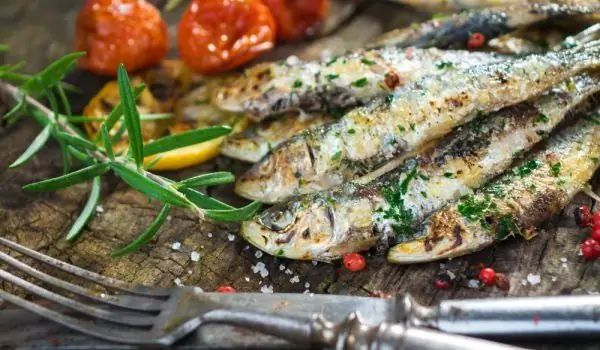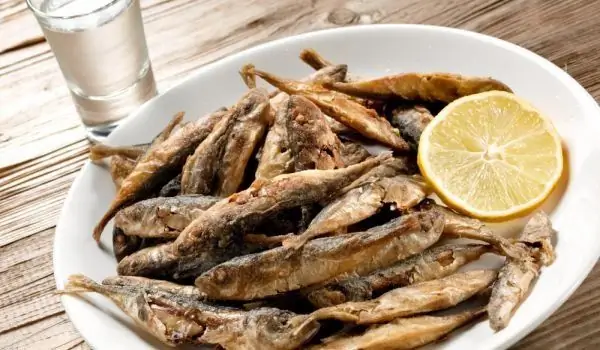2025 Author: Jasmine Walkman | [email protected]. Last modified: 2025-01-23 10:18
Horse mackerel (Trachurus) are a genus of predatory fish that inhabit saltwater and usually move in passages. I belong to the family Carangidae. They can be found in the Pacific, Atlantic and Indian Oceans, as well as in their seas. Horse mackerel features a large head.
The upper part of the body is painted gray and greenish. The lower part is colored in white or silver. Interestingly, horse mackerel has a dark spot on the gill cap. Horse mackerel can grow up to 40 centimeters in length. They can weigh up to half a kilogram. Of course, heavier specimens have been caught in isolated cases.
Types of horse mackerel
More than 15 species are present in the genus Trachurus horse mackerel. The Black Sea horse mackerel / Trachurus mediterraneus ponticus / is widespread in Bulgaria. He has a dark green back, which is blue in places. The side of the fish is grayish and the belly is colored silver to white. Black Sea horse mackerel has specific scales that are arranged in a well-defined line.
He has a relatively large head and large eyes. It also has a powerful jaw and small teeth. The Black Sea horse mackerel is usually no more than twenty centimeters long. Its weight does not exceed 100 grams. Smaller individuals are called graza, and larger ones - haimana.

Usual behavior of horse mackerel
Horse mackerel is a herd fish. Specimens of more modest size feed on zooplankton, and large horse mackerel attack small fish. They also eat crustaceans. Horse mackerel prefers warm waters and therefore with lower temperatures goes to areas where to spend the winter months. In some cases, when the winter turns out to be warmer, it stays on the Bulgarian coast, but if temperatures suddenly drop drastically, it cannot survive.
With warming temperatures comes the time to reproduce. The caviar is thrown in portions during the period from May to August. This happens at a distance of 10 to 30 kilometers from the shore, and the water temperature should be between 16-26 degrees. In the last days of September, the passages gather again for the next seasonal migration. Horse mackerel lives a relatively long time. Some species manage to survive up to 15 years.
Catching horse mackerel
This type of fish is of great economic importance. Experienced fishermen prepare to catch horse mackerel in the second part of May, when it approaches the coast during the breeding season. We have horse mackerel can be caught in the waters around Varna, Bourgas, Saint Vlas and Lozenets. This type of fish is caught on a bottom rod. In August and October it is fished for perch. As the hunting must be carried out from the shore.
Manure and sea worms, as well as shrimp are suitable baits for horse mackerel. Pieces of fish or mussels are used less often. When the horse mackerel bites, this is immediately noticeable by its sharp movements. However, this species is very timid, so when one bites, it should be removed as soon as possible, as there is a danger of frightening the other members of the herd.
Cleaning horse mackerel
The first step of cleaning horse mackerel is a thorough wash with cold water. Horse mackerel is a small fish, so those of the fish that are quite small are usually just released from the head without cutting their abdominal walls. In larger fish, the specific scales are cleaned, being careful as they can cause injury. The head is removed, and the entrails with it at the back. The fish is then washed once more and dried. You can salt the cleaned and dried fish and move on to its further processing.
Horse mackerel in cooking

Horse mackerel is a true seafood gift. The meat is very appetizing and reminiscent of mackerel. The fish is suitable for use in various specialties, as well as for canning. However, avid gourmets claim that it is tastier fried and its use in specialties is unnecessary.
In any case, the aroma that will dissipate while cooking the fish is indescribable. Especially if you season the tender meat with black pepper, garlic, parsley and dill. You can garnish the horse mackerel with products of your choice, as the vegetable additives best complement the taste of the fish. Pamid red wine is an excellent drink for horse mackerel.
Benefits of horse mackerel
Horse mackerel is not only a delicious food product, but also a valuable source of important ingredients. From it we can get calcium, copper, manganese, iodine, phosphorus, cobalt, iron, sodium, potassium, omega-3 fatty acids and more. Eating horse mackerel supports the cardiovascular system and supports the functioning of the heart. It also strengthens the activity of the thyroid gland.
The benefits of meat from horse mackerel don't end there. Regular consumption of this type of fish contributes to the stabilization of hemoglobin levels in the blood, as well as to strengthening the immune system. Eating fish is recommended for mental and physical exhaustion, lack of energy, fatigue and nervousness.
The other positive feature of horse mackerel is that it refers to lean fish, ie those that contain up to 5 percent fat, which makes it suitable for people who adhere to diets, as well as for those who have metabolic disorders.
Recommended:
The Table On St. Todor's Day Or Horse Easter

After Sirni Zagovezni, the Bulgarian church celebrates the church holiday Todorovden. The day is dedicated to St. Theodore Tyrone and is celebrated on the first Saturday after Zagovezni. This holiday is also called Horse Easter ! The tradition of St.
Horse Lasagna On The Bulgarian Market

Only two days after Minister Miroslav Naydenov assured the Bulgarian citizens that there are no imports of horse meat , 86 kg of lasagna with Bolognese sauce were banned by the Bulgarian Food Safety Agency. A signal for possible presence of products containing horse meat, instead of the beef indicated on the label, was received on 15.
Eat Fresh Sprats For Vitamin A And Horse Mackerel For Vitamin D

Very often, when we are going to cook fish, we go to the nearest grocery store and buy frozen fish. Yes, it is much faster and more convenient! But like most frozen products / fruits, vegetables /, fish is much more useful fresh than in the frozen version.
The Price Of Horse Mackerel Is Falling, The Catch Is Plentiful

The price per kilogram of horse mackerel drops to BGN 5 due to the abundant catch of fish since the beginning of the summer season, an inspection of the newspaper Tvoyat Den shows. In recent months, production has been high in Pomorie, Ahtopol, Primorsko and Nessebar.
They Also Found Horse Mackerel In Our Country

Another product, distributed on the Bulgarian market, contains content of horse meat . One of the samples sent earlier this month for testing in a German laboratory showed a positive result for unregulated horse meat content. Inspectors from the Bulgarian Food Safety Agency (BFSA) report a meat product sazdarma, in which 5% content of horse meat which are not marked on the label.

